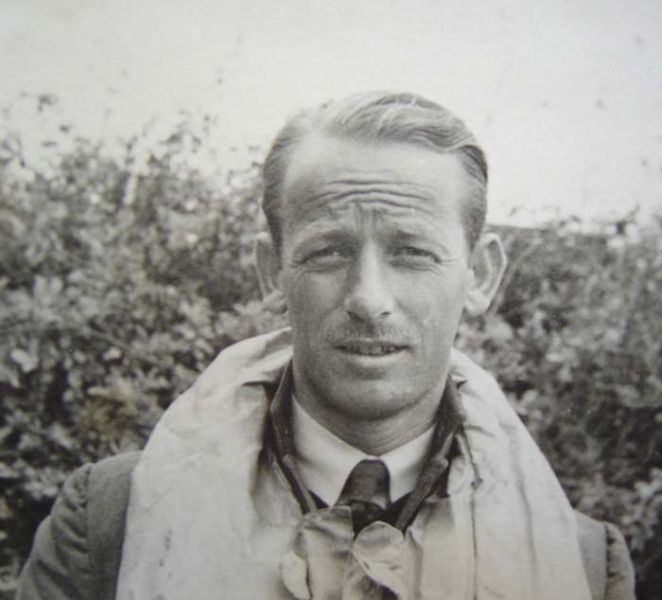Mayers, Howard Clive
- Date of birth:
- January 9th, 1910 (Sidney, Australia)
- Date of death:
- July 20th, 1942
- Service number:
- 77976, Royal Air Force Volunteer Reserves
- Nationality:
- Australian
Biography
Born in Sidney and attended Cambridge University. Son of George Russell Mayers and Penelope Mayers and married to Betty Mary Mayers.
In 1937 he joined the University Air Squadron and was called for the Royal Air Force Volunteer Reserve in 1940 and was placed with No. 601 Squadron. In May 1941 he was posted in the Middle East and took over command of No. 94 Squadron in July. In April 1942 he became Wing Leader with 239 Wing. After he was seen shooting down a Macchi C202 on 20th July 1942 he dissappeared. The wreck of his aircraft was found, but his body was not in it. He shot down a total of 11 planes confirmed and one possibly.
Do you have more information about this person? Inform us!
- Period:
- Second World War (1939-1945)
- Rank:
- Acting Squadron Leader
- Unit:
- Royal Air Force Volunteer Reserve
- Awarded on:
- January 1st, 1942
- Period:
- Second World War (1939-1945)
- Rank:
- Flying Officer
- Unit:
- No. 601 (County of London) Squadron, Royal Air Force
- Awarded on:
- October 1st, 1943
"This officer has participated in a number of interceptions and has destroyed seven enemy aircraft and possibly three others. During a recent engagement, a cannon shell passed through the port wing of his aircraft making a hole four feet in diameter, but Flying Officer Mayers succeeded in bringing his aircraft safely to base. He has displayed great courage and a fighting spirit."
Published in The London Gazette dated 1st October 1943.
- Period:
- Second World War (1939-1945)
- Rank:
- Acting Wing Commander
- Unit:
- No. 94 Squadron, Royal Air Force
- Awarded on:
- February 13th, 1942
Recommendation:
"This officer has led his wing on a large number of sorties during the Libyan Campaign. His mastery of tactics and skilful planning of operations have contributed largely to the successes obtained. On 29th December, 1941, during a machine gun attack against an enemy column, Wing Commander Mayers observed a member of his formation shot down by anti-aircraft fire. When the attack was concluded, he skilfully landed near the crashed aircraft and despite approaching enemy vehicles, coolly waited for his comrade to reach him. Putting him in the seat, Wing Commander Mayers clambered in on top of him and took off as the enemy approached. He finally flew safely to base. This officer has always shown great courage and leadership. He has destroyed at least 11 enemy aircraft."
Received as bar for on the ribbon of his first DFC.
Published in the London Gazette dated 13th February 1942.
"This officer has led his wing on a large number of sorties during the Libyan Campaign. His mastery of tactics and skilful planning of operations have contributed largely to the successes obtained. On 29th December, 1941, during a machine gun attack against an enemy column, Wing Commander Mayers observed a member of his formation shot down by anti-aircraft fire. When the attack was concluded, he skilfully landed near the crashed aircraft and despite approaching enemy vehicles, coolly waited for his comrade to reach him. Putting him in the seat, Wing Commander Mayers clambered in on top of him and took off as the enemy approached. He finally flew safely to base. This officer has always shown great courage and leadership. He has destroyed at least 11 enemy aircraft."
Received as bar for on the ribbon of his first DFC.
Published in the London Gazette dated 13th February 1942.
- Period:
- Second World War (1939-1945)
- Rank:
- Wing Commander
- Awarded on:
- July 28th, 1942
"W/Cdr. Mayers took over No. 239 Wing on 23.4.1942 1 squadron from this wing was the first to be fitted with Kittyhawk Bombers and another squadron was the first to be fitted with long range tanks. His tactical knowledge and personal interest in every operation has been a big factor in the success of the Kittyhawk Bomber and of the Long Range Kittyhawk Fighter, and his enthusiasm for both types overcame any reluctance on the squadron to be diverged from their normal role of air fighting. No. 6 Squadron with their Hurricane 11D’s were posted to this Wing and it was due entirely again to his tactical knowledge that No. 6 Squadron were able to have such success. In all cases he has led the first few operations where new tactics were employed.
On the 8/5 and the 12/5 he led both long range interceptions of supply aircraft on the Derna-Crete route, resulting in the interception of a large enemy force in which 13 (or 23 corrupt) JU 52’s were destroyed. On this sortie he personally destroyed 1 JU 52 and probably destroyed another. On 9/5 he led a Long-Range Escort to Benghazi with No. 250 Squadron and his part in planning the operation was a very important factor in its being carried out without loss. He is an expert in the art of bombing and straffing aerodromes, one of the most important being the attack on Gazala on 16/6. Which enabled our retreat from Gabut to Sidi Rezeig and LG 75 to be carried out without serious interference by 109’s.
Throughout the retreat his Wing has been able to operate intensively under his direction despite his administrative responsibilities during this difficult period."
Published in The London Gazette dated 28th July 1942.
Awarded posthumously.
- Period:
- Second World War (1939-1945)
- Period:
- Second World War (1939-1945)
- Period:
- Second World War (1939-1945)
Sources
- Photo 1: Tom MacNeill
- - The London Gazette, Issue 34958, dated Tuesday 1st October 1940
- Australian war Memorial
- Spink









